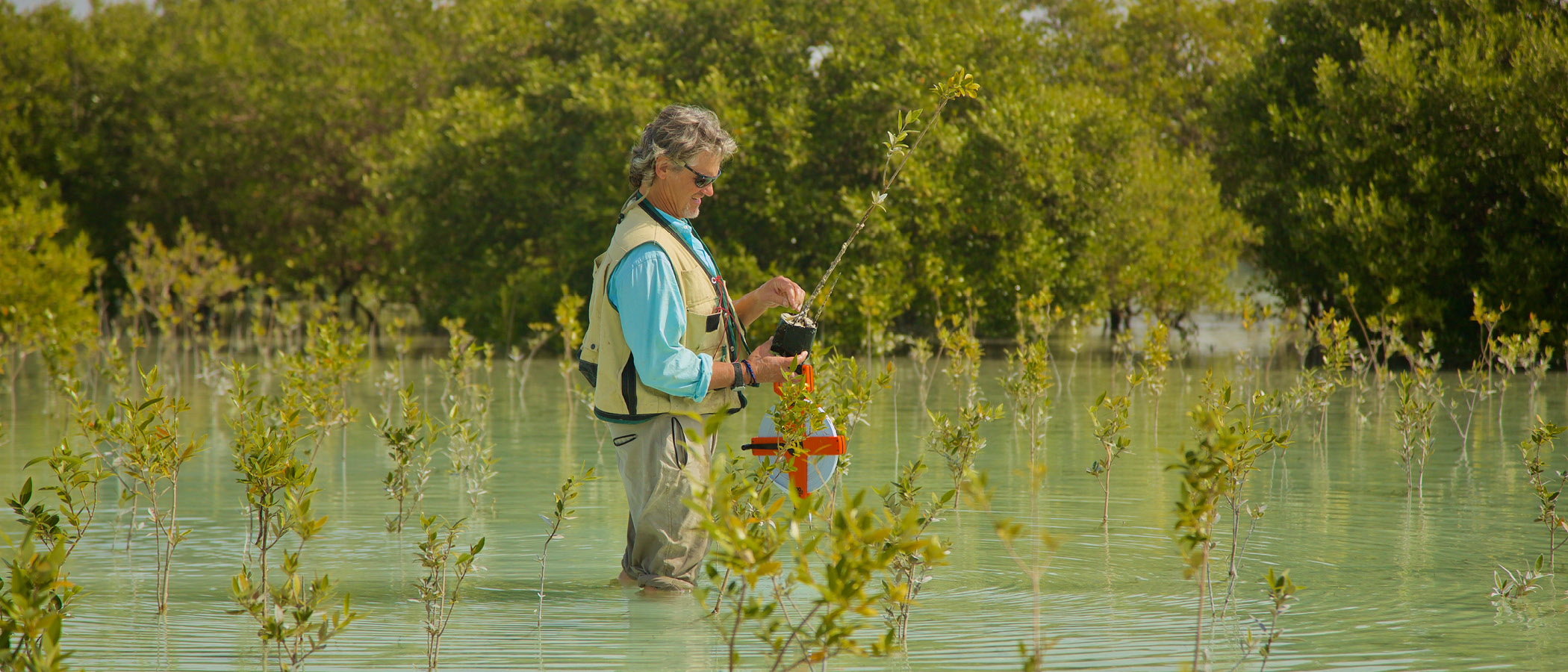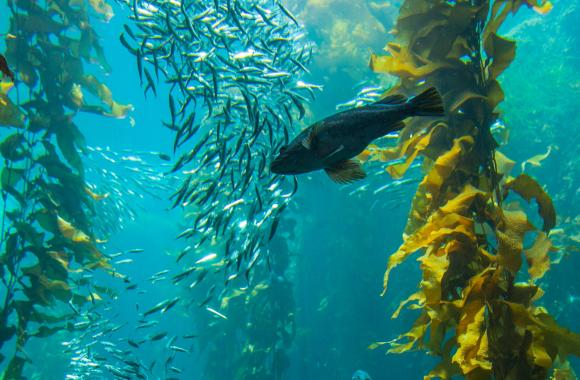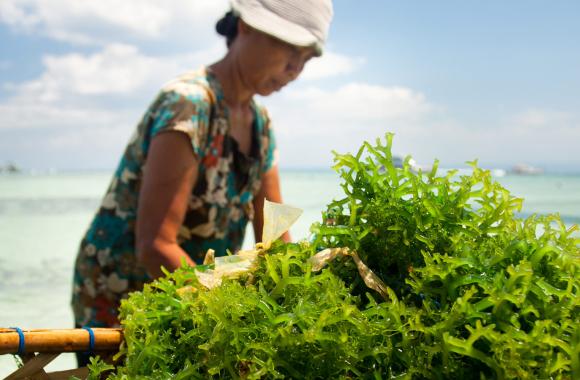Coastal Wetland Restoration
Agriculture, development, and natural disasters have degraded many coastal wetlands. Restoring mangrove forests, salt marshes, and seagrass beds to health revives carbon sequestration.
Reduced/Sequestered
2020–2050
Impact
Like forest and peatlands, coastal wetlands are subject to severe degradation. Restoring mangroves, salt marshes, and seagrasses reduces greenhouse gas emissions. It also enhances their ability to support biodiversity and provide ecosystem services. Protecting 6.06–7.19 million hectares of currently degraded coastal wetlands and allowing natural regrowth to occur would sequester 0.76–1.00 gigatons of carbon dioxide-equivalent greenhouse gases by 2050.
Introduction
Unlike most terrestrial ecosystems, coastal wetlands—salt marshes, mangroves, and seagrasses—can continue sequestering carbon for centuries without becoming saturated. In fact, coastal wetlands can store five times as much carbon as tropical forests over the long term, mostly in deep wetland soils. As a result, they have accumulated vast stores of carbon, making their greenhouse gas mitigation potential high despite their small area. Coastal wetlands also provide important ecosystem services.
Development, agriculture, and other human activity are rapidly degrading or destroying coastal wetlands. Disturbance of coastal wetlands contributes an estimated 1–10 percent of anthropogenic greenhouse gas emissions.
Project Drawdown’s Coastal Wetland Restoration solution involves the use of processes that seek to restore coastal wetlands (including mangroves, seagrasses, and salt marshes) to prior conditions, whether naturally or through human intervention. It replaces the practice of allowing degraded coastlines to remain degraded.
Methodology
Total Land Area
We set current adoption of the Coastal Wetland Restoration solution to 0.
Adoption Scenarios
We developed six custom adoption scenarios for each of the three coastal wetland ecosystems using a linear growth curve based on Guatemala’s National Restoration Strategy, which aims to restore 10,000 hectares of mangroves between 2015 and 2045, and Green India Mission, which included a commitment to restore 100,000 hectares of mangroves between 2010 and 2020. Lacking similar information for seagrasses and salt marshes, we projected restoration of these coastal wetlands by applying mangroves’ restoration rate to these ecosystems’ respective total land area and degradation rate. Given the small area of coastal wetlands and the high adoption potential of restoration, some scenarios reached peak adoption by 2030.
We calculated impacts of increased adoption of the Coastal Wetland Restoration solution from 2020 to 2050 by comparing two growth scenarios with a reference scenario in which the total land area allocated to coastal wetlands was fixed at the current levels.
- Scenario 1: 6.06 million hectares of unprotected coastal wetlands are protected (83 percent of the total land area).
- Scenario 2: 7.19 million hectares of unprotected coastal wetlands are protected (98 percent of the total land area).
Emissions, Sequestration, and Yield Model
We set sequestration rates for mangroves at 6.58 metric tons of carbon per hectare per year, based on meta-analysis of 27 data points from 13 sources. Salt marsh sequestration rates are 0.93 metric tons of carbon per hectare per year, based on 15 data points from six sources. Seagrass sequestration was 0.99 metric tons of carbon per hectare per year, based on 16 data points from four sources.
Financial Model
We did not model financials because costs do not necessarily accrue to the landowner or land manager.
Integration
Integration with other solutions did not affect this solution because coastal wetlands are largely distinct from terrestrial land uses. We included mangroves in the Forest land use model but gave them highest priority, so they were not limited by other forest land uses.
Results
Scenario 1 reduces emissions by 0.76 gigatons of carbon dioxide equivalent by 2050. Scenario 2 reduces emissions by 1.00 gigatons of carbon dioxide-equivalent by 2050.
Discussion
The International Union for the Conservation of Nature and The Nature Conservancy report that halving coastal wetland destruction would reduce annual emissions 0.23 gigatons of carbon dioxide per hectare per year (Herr and Landis, 2016). Griscom et al. (2017) calculated 0.18–0.30 gigatons of carbon dioxide equivalent per year in 2030. The Project Drawdown Coastal Wetland Protection and Coastal Wetland Restoration solution models showed a maximum annual reduction of only 0.03–0.06 gigatons in 2030. This lower impact could be attributed to the lower degradation rate in our models, where multiple sources citing the same degradation rate are excluded from the analysis in order to avoid double counting.
Future upgrades of this solution should calculate net costs and savings. More data on salt marsh and seagrass sequestration and emissions rates are needed.
Coastal wetlands harbor a disproportionate share of the world's stored carbon. They also provide critical ecosystem services. Thus, aggressive efforts to protect these ecosystems are an important component of climate change mitigation efforts.
References
Griscom, B. W., Adams, J., Ellis, P. W., Houghton, R. A., Lomax, G., Miteva, D. A., Schlesinger, W. H., Schoch, D., Siikamäkia, J. V., Smith, P., Woodbury, P., Zganjar, C., Blackman, A., Campari, João, Contant, R. T., Delgado, C., Elias, P., Gopalakrishna, T., Hamsik, M. R., Herrero, M., Kiesecker, J., Landis, E., Laestadius, L., Leavitt, S. M., Minnemeyer, S., Polasky, S., Potapov, P., Putz, F. E., Sanderman, J., Silvius, M., Wollenberg, E., and Fargione, J. (2017). Proceedings of the National Academy of Sciences, 114 (44) pp 11645-11650. http://www.pnas.org/content/114/44/11645
Herr, D. and Landis, E. (2016). Coastal blue carbon ecosystems: Opportunities for Nationally Determined Contributions, Policy brief. International Union for Conservation of Nature and The Nature Conservancy. https://wedocs.unep.org/bitstream/handle/20.500.11822/34030/CBE.pdf?sequence=1&isAllowed=y
What You Can Do
If you live near a coast, write a letter to the editor on the role mangroves, seagrasses, and salt marshes play in protecting your community.
Volunteer with, or contribute to, an organization that works to protect coastal ecosystems.
- Expand your knowledge by exploring another Drawdown solution.
Co-benefits
Coastal wetland protection mitigates the impacts of extreme climate events such as hurricanes, floods, and sea-level rise.
In many countries, particularly small island developing states, mangroves and other coastal ecosystems support subsistence fisheries that are critical for food security.



